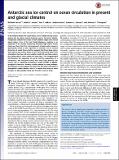Files in this item
Antarctic sea ice control on ocean circulation in present and glacial climates
Item metadata
| dc.contributor.author | Ferrari, Raffaele | |
| dc.contributor.author | Jansen, Malte F. | |
| dc.contributor.author | Adkins, Jess F. | |
| dc.contributor.author | Burke, Andrea | |
| dc.contributor.author | Stewart, Andrew L. | |
| dc.contributor.author | Thompson, Andrew F. | |
| dc.date.accessioned | 2014-09-10T15:01:02Z | |
| dc.date.available | 2014-09-10T15:01:02Z | |
| dc.date.issued | 2014-06-17 | |
| dc.identifier | 147214466 | |
| dc.identifier | 9646968a-b518-4045-830c-4a217135eff0 | |
| dc.identifier | 000337300100024 | |
| dc.identifier | 84902602972 | |
| dc.identifier.citation | Ferrari , R , Jansen , M F , Adkins , J F , Burke , A , Stewart , A L & Thompson , A F 2014 , ' Antarctic sea ice control on ocean circulation in present and glacial climates ' , Proceedings of the National Academy of Sciences of the United States of America , vol. 111 , no. 24 , pp. 8753-8758 . https://doi.org/10.1073/pnas.1323922111 | en |
| dc.identifier.issn | 0027-8424 | |
| dc.identifier.other | ORCID: /0000-0002-3754-1498/work/64034534 | |
| dc.identifier.uri | https://hdl.handle.net/10023/5401 | |
| dc.description | All authors acknowledge support from the National Science Foundation. R.F. acknowledges support from the Breene M. Kerr Chair. | en |
| dc.description.abstract | In the modern climate, the ocean below 2 km is mainly filled by waters sinking into the abyss around Antarctica and in the North Atlantic. Paleoproxies indicate that waters of North Atlantic origin were instead absent below 2 km at the Last Glacial Maximum, resulting in an expansion of the volume occupied by Antarctic origin waters. In this study we show that this rearrangement of deep water masses is dynamically linked to the expansion of summer sea ice around Antarctica. A simple theory further suggests that these deep waters only came to the surface under sea ice, which insulated them from atmospheric forcing, and were weakly mixed with overlying waters, thus being able to store carbon for long times. This unappreciated link between the expansion of sea ice and the appearance of a voluminous and insulated water mass may help quantify the ocean's role in regulating atmospheric carbon dioxide on glacial-interglacial timescales. Previous studies pointed to many independent changes in ocean physics to account for the observed swings in atmospheric carbon dioxide. Here it is shown that many of these changes are dynamically linked and therefore must co-occur. | |
| dc.format.extent | 6 | |
| dc.format.extent | 2416714 | |
| dc.language.iso | eng | |
| dc.relation.ispartof | Proceedings of the National Academy of Sciences of the United States of America | en |
| dc.subject | Carbon cycle | en |
| dc.subject | Ice age | en |
| dc.subject | Ocean circulation | en |
| dc.subject | Paleoceanography | en |
| dc.subject | Southern Ocean | en |
| dc.subject | GC Oceanography | en |
| dc.subject | GE Environmental Sciences | en |
| dc.subject | BDC | en |
| dc.subject | R2C | en |
| dc.subject | SDG 13 - Climate Action | en |
| dc.subject.lcc | GC | en |
| dc.subject.lcc | GE | en |
| dc.title | Antarctic sea ice control on ocean circulation in present and glacial climates | en |
| dc.type | Journal article | en |
| dc.contributor.institution | University of St Andrews. School of Earth & Environmental Sciences | en |
| dc.contributor.institution | University of St Andrews. St Andrews Isotope Geochemistry | en |
| dc.contributor.institution | University of St Andrews. Earth and Environmental Sciences | en |
| dc.identifier.doi | https://doi.org/10.1073/pnas.1323922111 | |
| dc.description.status | Peer reviewed | en |
This item appears in the following Collection(s)
Items in the St Andrews Research Repository are protected by copyright, with all rights reserved, unless otherwise indicated.

